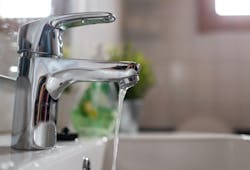Handling the Pressure: The Effect of Plumbing Material Selection on Homeowner Satisfaction
When media personality and businesswoman Kylie Jenner shared a video of her pink marble shower on Instagram, it wasn’t the craftsmanship or opulence that attracted attention. It was the water pressure. And it probably wasn’t the attention she expected.
One of the kinder responses to the anemic flow from her showerhead noted, “Something about having better water pressure than Kylie Jenner gives me a little hope.”
There are, of course, a number of factors that can contribute to low water pressure. But one that doesn’t get enough attention is the impact of plumbing material choices. Plastic pipes and fittings have displaced copper in many residential markets due to their lower cost and ease of installation. But different plastic materials have different performance characteristics that can impact both water pressure and quality.
Fittings that Restrict Flow
The top two choices in plumbing today are CPVC (Chlorinated PolyVinyl Chloride) and PEX (cross-linked polyethylene). One key difference between the two is the type of fitting used.
CPVC uses a solvent weld process to secure full-flow fittings to the pipes, similar to copper but without the fire hazard introduced by soldering. As a result, CPVC can be sized the same as copper, creating minimal drop in water pressure.
PEX, on the other hand, uses fittings which are inserted into the pipe so that the internal diameter is reduced at each fitting, which can interrupt the flow and reduce water pressure. This is true even with expansion fittings, which are 10-20% smaller than the pipe – despite manufacturer claims of being “full flow”.
Depending on the fitting, the internal diameter of a ½” PEX pipe is reduced anywhere from 21% to 35%; that translates into a drop of 2 to 4 psi for each 90-degree elbow fitting in the system. Other fitting types can create similar drops and can noticeably reduce water pressure at fixtures unless pipes are oversized.
Risks to Water Quality
As builders increasingly focus on building healthier homes, the role of water quality is getting new attention. Plumbing systems can affect a home’s water quality in a variety of ways, including permeation, leaching and biofilm formation.
Permeation occurs when chemicals that come in contact with the outside of a piping system soak through the pipe wall and enter the water supply. According to the EPA, vinyl plastics such as CPVC are “virtually impermeable” at low levels of contamination and would actually fail before allowing the water to become contaminated. However, the same EPA study found that 82% of known permeation incidents occurred with polyolefin plastics – the group which includes PEX.
The industry standard for water quality impacts is NSF 61. While CPVC pipes, fittings and cements are certified to NSF 61 under all water conditions, both copper and some PEX brands have limited NSF 61 certifications based on either the pH or temperature of the water. In addition, some brands of PEX piping have been shown to leach gasoline components such as MTBE at levels in excess of state water quality regulations in at least 13 states.
Lastly, biofilms can harbor and encourage the growth of bacteria such as legionella and E.coli in the home’s water supply. Numerous tests have shown that CPVC consistently shows one of the lowest biofilm formation potentials, while PEX consistently shows a higher potential for biofilm growth.
A study conducted by researchers at Virginia Tech looked at the overall water quality impacts of plumbing systems and found that “CPVC was the most inert of the materials tested and had the least impact on water quality.”
The Value of the Right Materials
The plumbing materials you choose can have a notable effect on homeowner satisfaction. Using plastic plumbing doesn’t have to mean accepting performance compromises. By choosing the right material, you can maximize your water pressure and reliably deliver clean, safe drinking water.

